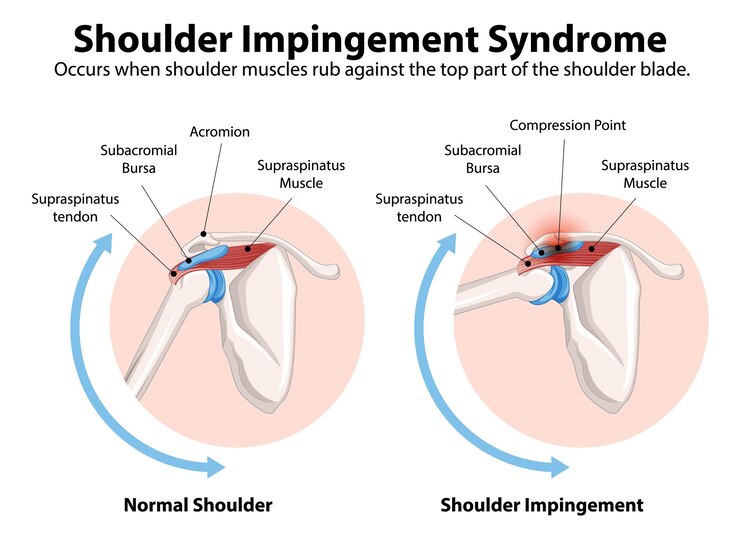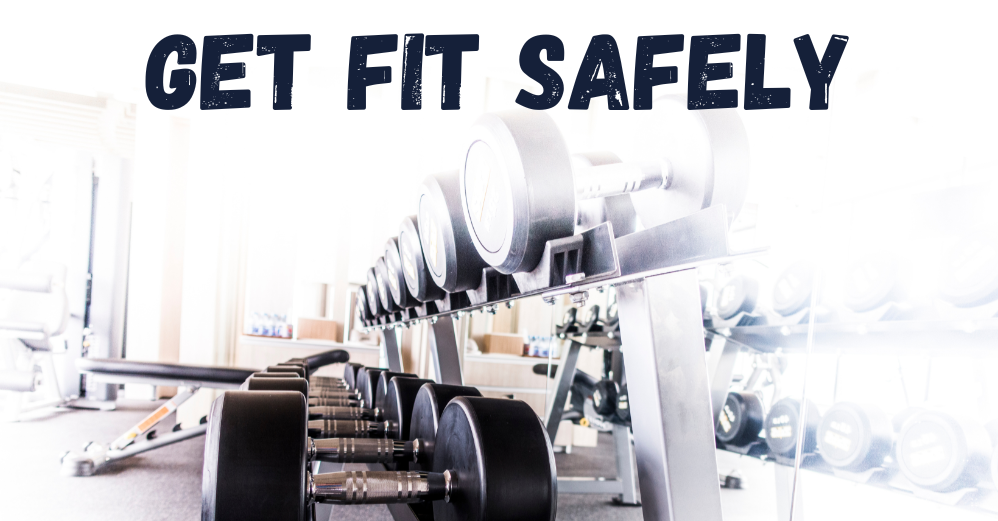If you’ve ever felt that strange twinge in your shoulder during a workout and thought, “Can I really keep training?” you’re not alone.
You might lift weights like a superhero one day.
The next day, just raising a glass makes your shoulder scream for vengeance.
Welcome to the club.
Subacromial impingement isn’t just a fancy term doctors use to sound impressive — it’s real, it’s sneaky, and if you ignore it, it’ll bench you faster than a surprise disqualification.
Today we’ll look at which exercises you should avoid if you’re even feeling a hint of shoulder impingement.
And trust me: I’ve been there too, stubborn as a mule, and I got the full experience — ice packs, painkillers, and sleepless nights included.
What Exactly Is Subacromial Impingement?

Imagine your shoulder joint as a super-busy intersection.
Tendons, muscles, bones — all trying to move at once without stepping on each other’s toes.
When the space between the humerus (upper arm bone) and the acromion (that little bony roof over your shoulder) shrinks, the rotator cuff tendons get pinched.
And that’s where impingement comes in.
At first it might just feel odd.
A little pinch.
You might think you slept wrong.
But if you keep ignoring it, it gets worse. Fast.
Other Types of Shoulder Impingement You Should Know About

Okay, subacromial impingement is the most famous (and also the most common, especially among gym-goers).
But it’s not the only way your shoulder can start protesting.
If you really want to understand what can go wrong up there in the joint, here are the other types of impingement you should know:
Internal Impingement
It’s more common in athletes who do overhead sports like baseball, tennis, volleyball, or swimming.
Here the problem isn’t between the acromion and the humerus, but inside the joint itself: the head of the humerus irritates the glenoid labrum and the back of the rotator cuff.
You usually feel pain during extreme external rotation or when loading overhead.
It can be sneaky, because at rest it might not bother you… and then as soon as you throw or push hard, bam!
Coracoid Impingement
Less well known, but it can be very painful.
It occurs when the subscapularis tendon is compressed between the coracoid process (a small bony projection in front of the scapula) and the head of the humerus.
Pain is felt mainly in the front of the shoulder.
It worsens with forward-pressing movements or when you bring your elbows close to your body under load.
Exercises That Worsen Impingement (And Why You Should Steer Clear)
If you think a little discomfort is nothing, beware.
These exercises can turn it into a serious problem before you even notice.
- Barbell Military Press (Especially with Heavy Loads)
Lifting a straight bar overhead when your joint space is already reduced is like trying to fit a pumpkin into a bottle. If you must press overhead, opt for light dumbbells, a neutral grip, or landmine presses. - Upright Rows
This old-school favorite forces your shoulder into internal rotation as you lift, mercilessly pinching the tendons. Replace it with face pulls or cable rows, and your shoulder will send you a thank-you postcard. - Behind-the-Neck Movements
Behind-the-neck presses, pull-ups, or lat-machine variations are brutal unless you’re as flexible as a contortionist. Stick to movements in front of your body instead. - Deep Dips
Deep dips look cool, but they force your shoulder into extreme extension. If your subacromial space is already under stress, you risk inflaming the whole system. If it hurts, reduce depth or switch exercises—no guilt. - Heavy Lateral Raises
When you load up lateral raises, your traps end up doing the work, not your delts. Meanwhile, your shoulder gets squished like an overstuffed sandwich. Stick to light weights, controlled motion, and stop at shoulder height.
Also Watch Out for Bodyweight Exercises
- Push-ups that go too deep
- Handstand push-ups (out-of-control vertical pressing)
- Poorly executed bear crawls (uneven shoulder loading)
The trick is always controlling the movement.
What Can I Do to Keep Training Without Making It Worse?
Here’s the good news: you can (and should) keep training!
You just need smart modifications that reduce shoulder strain while maintaining progress.
Smart Modifications to Keep You Training:
- Landmine Presses:
Press the barbell diagonally overhead with your elbow close to your body—safer than strict overhead pressing. - Incline Dumbbell Press (Light):
Use a 30–45° bench and press without letting your shoulders roll forward. - Partial Lateral Raises:
Lift dumbbells only up to shoulder height, slow and controlled—no momentum. - External Band Rotations:
Keep your elbow tucked in and rotate your forearm outward without shrugging.
The Secret Weapon: Scapular Strength
If your scapulae and upper back muscles are weak, your shoulder starts off at a disadvantage. Strengthening these stabilizers can be a game changer.
Top 3 Scapula-Focused Moves:
- Face Pulls:
Pull a rope or band toward your face with elbows high and shoulders down—great for rear delts and scapular control. - Scapular Push-ups:
Do push-ups focusing only on moving your shoulder blades—no elbow bending. - Y-Raises:
Lift your arms into a Y-shape using light weights or a band, keeping the motion smooth and controlled.
Before You Start: How to Warm Up Your Shoulders Like a Pro (5–7 Minutes)
Working out without warming up, especially with an angry shoulder, is like running a marathon with untied shoes.
You need to prepare your joints in an intelligent and targeted way.
Here’s a quick but super-effective routine I recommend always doing before workouts:
- Thoracic Extension on Foam Roller:
Lie with the roller under your shoulder blades and gently extend backward to open your chest.
Objective: Boost thoracic mobility and prep your posture for safe pressing. - Band Pull-Aparts:
Hold a band with arms extended in front of you, then pull outward while keeping your scapulae down and active.
Objective: activate the upper back immediately - Mini-Band External Rotations:
Place the band on your forearms, elbows tight at your sides, and rotate outward slowly without moving your shoulder.
Objective: warm up the small but essential rotators - Arm Circles:
Arms extended, start with small circles and gradually increase diameter—30 seconds forward, then 30 seconds backward.
Objective: improve joint fluidity - Scapular Wall Slides:
Back against the wall, slide your hands and elbows up and down without losing contact.
Objective: scapular coordination and stability - Light Isometric Lateral Raises:
Lift light dumbbells halfway, hold isometric for 1–2 seconds before lowering.
Objective: engage the deltoid without stressing it
How to Manage Pain Without Losing Your Mind
Training poorly is the fastest way to end up crying in front of the ice spray.
To protect yourself, you need targeted recovery work as well:
- Gentle Chest and Lat Stretches:
Press your arm against a wall or door frame, rotate your torso to stretch your chest gently; for lats, raise your arm overhead and lean sideways. - Thoracic Extension on Foam Roller (Recovery Version)
Same setup as in your warm-up, but now done slowly and passively to relieve tension. - Brief Passive Hangs for Decompression:
Hang from a bar (pronated or neutral grip), relax your shoulders, and let your body weight naturally stretch the joints—no swinging.
When to See a Physical Therapist
- After 2–3 Weeks with No Improvement
- Pain That Wakes You at Night
- Everyday Movements Cause Pain
Don’t hesitate: it’s better to get checked now while you still can, rather than regret months of downtime later.
In these cases, a physical therapist will not only help you reduce pain, but will also teach you specific exercises to safely reactivate your shoulder.
Here are some typical physical therapy exercises:
- External Rotations with a Band
Elbow bent at 90° close to the side, pull the band by rotating your forearm outward.
Goal: strengthen the external rotators and improve stability. - Scapular Retractions with a Band
Hold the band in front of your chest, pull by widening your arms while keeping your scapulae down and adducted.
Goal: activate the middle trapezius and rhomboids, essential for shoulder protection. - Scapular Setting
Standing or seated, “set” your scapulae by pulling them slightly down and together without tensing your neck.
Hold for 10–15 seconds.
Goal: improve neutral position and scapular postural control. - Bodyweight Shoulder Extensions
Arms by your sides, extend them slightly backward without bending the elbows—small, controlled movement.
Goal: strengthen the posterior shoulder muscles without excessive load. - Pendulum Exercises
Supported on a table with one hand, let the other arm swing gently forward and backward, then side to side.
Goal: mobilize the joint without direct load, reducing stiffness and pain.
A Simple, Safe Program to Keep Training Your Shoulders
You don’t have to stop.
In fact, intelligent movement is your best ally for healing.
Here’s a small weekly plan designed specifically to train your shoulders safely without further inflammation:
- Monday:
- Landmine Press 4×8 (Press without crushing the joints)
- Cable Row 4×10 (Keep scapulae stable)
- Scapular Push-ups 3×12 (Wake up the deep musculature)
- Wednesday:
- Incline Dumbbell Press 3×12 (More natural shoulder angle)
- Face Pulls 4×15 (Gold-standard work for cuff and posture)
- Single-Arm Landmine Row 3×10 (Total control throughout the movement)
- Friday:
- Light Partial Lateral Raises 3×15 (No jerks, just smooth fluid motion)
- Band External Rotations 3×20 (Cuff armored, zero stress)
- Passive Hangs 3×20 seconds (Create space and natural decompression)
Bonus tip: always take at least one day of active recovery between sessions to give your tissues time to heal!
RELATED:》》》Is Heavy Overhead Pressing Actually Hurting My Shoulder Joint Long-Term?
Conclusion
Protecting your shoulder now doesn’t mean training less.
It means training smarter.
With patience, strategy, and respect for your body, you can not only lift heavy again, but do so without the thought of pain lurking around the corner.
Shoulders aren’t a body part to improvise.
They’re your ticket to a future of strength, freedom, and movement without limits.
Take care of them today… and tomorrow you’ll be unstoppable.





